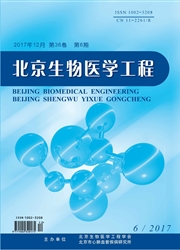

 中文摘要:
中文摘要:
探讨2450MHz微波天线比吸收率(SAR)的空间分布规律,以掌握微波天线的加热能力.以离体猪肝作为微波热消融实验对象,分别采用5组常用微波功率40W、50W、60W、70W和80W进行加热,每组以40例样本做热消融实验.实验中,每例样本被精确固定布放16个测温针并且分别进行前向和后向测温.结果 表明,SAR前、后向分布具有非对称性,从天线中心向四周有规律地衰减,并且SAR与加热功率之间没有线性关系,但数值随着加热功率增大而增大.近场点的温度模拟结果与实测值具有较好的一致性,从而验证了SAR检测结果的准确性.因此,该实验研究微波天线SAR分布的方法是有效的,SAR检测结果可用于温度场计算机模拟中的热载荷.
 英文摘要:
英文摘要:
In order to understand the heating ability of microwave antenna, the spatial distribution pattern of special absorption rate was explored with 2450MHz microwave antenna. Five-group ablated experiments with the heating power of 40W ,50W ,60W,70W and 80W were performed to in-vitro pig livers. Forty samples of thermal ablation were repeated for each group. In each test, sixteen thermometers were precisely located and the temperature measurements were performed both forward and backward directions. Experimental results demonstrated that the SAR were asymmetric in forward and backward directions and decreased regularly around from antenna center. There was no linear relationship between SAR and heating power however the value of SAR increased with the heating power. Based on good consistency between temperature simulation and the real temperature measurement, in the field near temperature center, the accuracy of the SAR examination was evaluated. In conclusion, experimental study of SAR distribution of microwave antenna is effective and detection results of SAR can be applied to thermal load in computer simulation of temperature field.
 同期刊论文项目
同期刊论文项目
 同项目期刊论文
同项目期刊论文
 Ultrasound monitoring of temperature and coagulation change during tumor treatment with microwave ab
Ultrasound monitoring of temperature and coagulation change during tumor treatment with microwave ab 期刊信息
期刊信息
